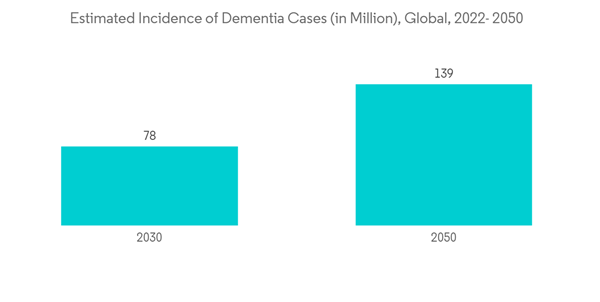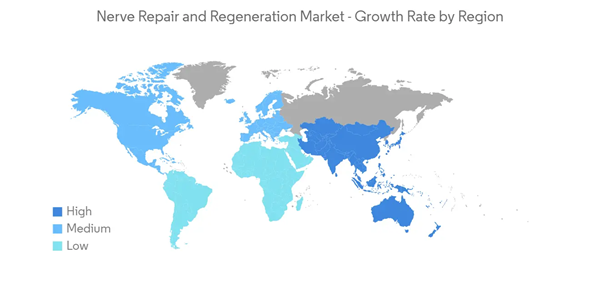COVID-19 had a significant impact on the growth of the market over the forecast period. The SARS-CoV-2 showed to case nerve injuries in the infected patients, which impacted the demand for nerve repair and regeneration market during the pandemic period. For instance, the NCBI article published in March 2021, mentioned that peripheral nerve injury could occur in patients with COVID-19 secondary to postinfectious inflammatory neuropathy, prone positioning-related stretch and/or compression injury, systemic neuropathy, or nerve entrapment from hematoma. Such incidence of nerve injuries among the infected patients had a notable impact on the growth of the market during the pandemic period. Also, the resumption of nerve repair and regeneration procedures during the post-pandemic period is expected to contribute to the market's growth over the forecast period.
The market is expected to show growth due to the growing incidence of nerve injuries and the high prevalence of neurological disorders, technological advancements for nerve repair and regeneration, and the rise in healthcare expenditure by the government with favorable policies in the developed market.
The increase in neurological diseases is found to be the major contributor to the global burden of disease. There are various nervous system disorders, including cerebrovascular disease, Alzheimer’s disease, other dementias, migraine, epilepsy, tetanus, meningitis, Parkinson's disease, and multiple sclerosis, among others. For instance, the WHO data published in February 2022 mentioned that around 50 million people worldwide have epilepsy, and nearly 80% of people worldwide live in low and middle-income countries in 2022. Additionally, the American Heart Association report published in 2021 mentioned that globally the prevalence of intracerebral hemorrhage was 20.7 million cases, and that of subarachnoid hemorrhage was 8.4 million in 2021. Such a high incidence of various neurovascular disorders among the global population giving rise to the demand for nerve repair and regeneration is expected to contribute to the market's growth over the forecast period.
Apart from the rising cases of neurological disorders, a strong product pipeline and product approvals of the major companies are also expected to contribute to the market's growth. For instance, in March 2021, Helius Medical received marketing authorization from the US FDA for the Portable Neuromodulation Stimulator (PoNS) device. The PoNS device is indicated for use as a short-term treatment of gait deficit due to mild-to-moderate symptoms from multiple sclerosis and is to be used as an adjunct to a supervised therapeutic exercise program. Also, in February 2021, ShiraTonics received the device designation Center of Devices and Radiological Health (CDRH) of the FDA for its innovative neurostimulation therapy targeting chronic migraine.
However, the high cost associated with the devices and the lack of trained personnel are expected to restrain the market's growth over the forecast period.
Nerve Repair & Regeneration Market Trends
Stem Cell Therapy in the Application Segment is Expected to Witness the Fastest CAGR Over the Forecast Period in the Nerve Repair and Regeneration Market
Stem cells could be useful for treating neurodegenerative disorders by replacing impaired and dead or dying neural cells following differentiation. The stem cell therapy segment is expected to witness the fastest CAGR due to the increasing incidence of neurological disorders, coupled with growing demand for effective treatment options, various government initiatives, and approvals to conduct clinical trials of biomaterials.For instance, the data published by WHO in September 2022, reported that more than 55 million people are living with dementia worldwide in 2022, and there are nearly 10 million new cases every year. The report also mentioned that as the proportion of the older population is increasing worldwide, the number of dementia cases is expected to rise to 78 million by 2030 and 139 million by 2050.
The increasing research and developmental activities by various organizations and funding for the development of advanced stem cell therapies in the treatment of neurological disorders are also expected to contribute to the growth of the studied segment. For instance, in April 2021, UCLA researchers reported that a one-time injection of an experimental stem cell therapy could repair brain damage and improve memory function in mice with conditions that replicate human strokes and dementia. On the Other hand, in November 2031, Neuroplast raised a total of EUR 10 million (USD 11.5 million) in funding from investors to further advance the clinical development of a transformative stem cell therapy for traumatic spinal cord injury.
Thus, the increasing incidence of various neurological disorders, along with rising research and developmental activities and funding, are expected to contribute to the growth of the studied segment.
North America is Expected to Hold a Significant Share in the Market Over the Forecast Period
North America is expected to hold a significant share of the market owing to the increasing incidence of neurological disorders and the quick adoption of technologically advanced products. Additionally, the presence of key market players and frequent product developments in this region is expected to play a crucial role in the market's growth.For instance, the NCBI article published in March 2021 mentioned that an estimated 6.2 million Americans age 54 and older were living with Alzheimer's dementia in 2021. this number was expected to reach 13.8 million by 2060. Additionally, the Florida Health data in June 2022 mentioned that approximately 0.6% of children in the United States were diagnosed with epilepsy in 2021. Likewise, the Alzheimers Society of Canada data in September 2022 reported that in Canada, over 600,000 people are living with dementia. By 2050, more than 1.7 million Canadians are expected to be living with dementia. Such increases in neurological disorders are expected to drive the demand for nerve repair and regeneration, thereby contributing to the growth of the market.
Moreover, the increasing product developments by various market players and product approvals in North America are expected to favor the market's growth in this region. For instance, in March 2022, MyndTec received FDA approval for MyndMove 2.0, its second-generation neuromodulation MyndMove system. The MyndMove system is a touch screen, eight-channel neuromodulation device that delivers short electrical pulses to stimulate muscle contractions and enhance motor recovery. Also, in June 2021, Medtronic received approval from FDA for their product SenSight directional lead system used for deep brain stimulation therapy. The Sensight implants both send electric signals to treat movement disorders such as Parkinson's disease and capture brain signals that may inform the care of the patient.
Therefore, the above-mentioned factors, such as increasing neurological disorders, growing demand for nerve repair and regenerative therapies along with increasing product developments, are expected to contribute to the growth of the market in this region.
Nerve Repair & Regeneration Market Competitor Analysis
The Nerve Repair and Regeneration Market is fragmented and competitive due to the presence of several market players. In terms of market share, a few of the major players are currently dominating the market. Some of the key companies are Abbott Laboratories, Axogen Corporation, Baxter, and Boston Scientific Corporation.Additional benefits of purchasing the report:
- The market estimate (ME) sheet in Excel format
- 3 months of analyst support
This product will be delivered within 2 business days.
Table of Contents
Companies Mentioned (Partial List)
A selection of companies mentioned in this report includes, but is not limited to:
- Abbott Laboratories
- Axogen Corporation
- Baxter
- Boston Scientific Corporation
- Integra LifeSciences Corporation
- Livanova
- Medtronic
- NeuroPace Inc.
- Neuronetics
- Stryker
- Phagenesis
- MyndTec










